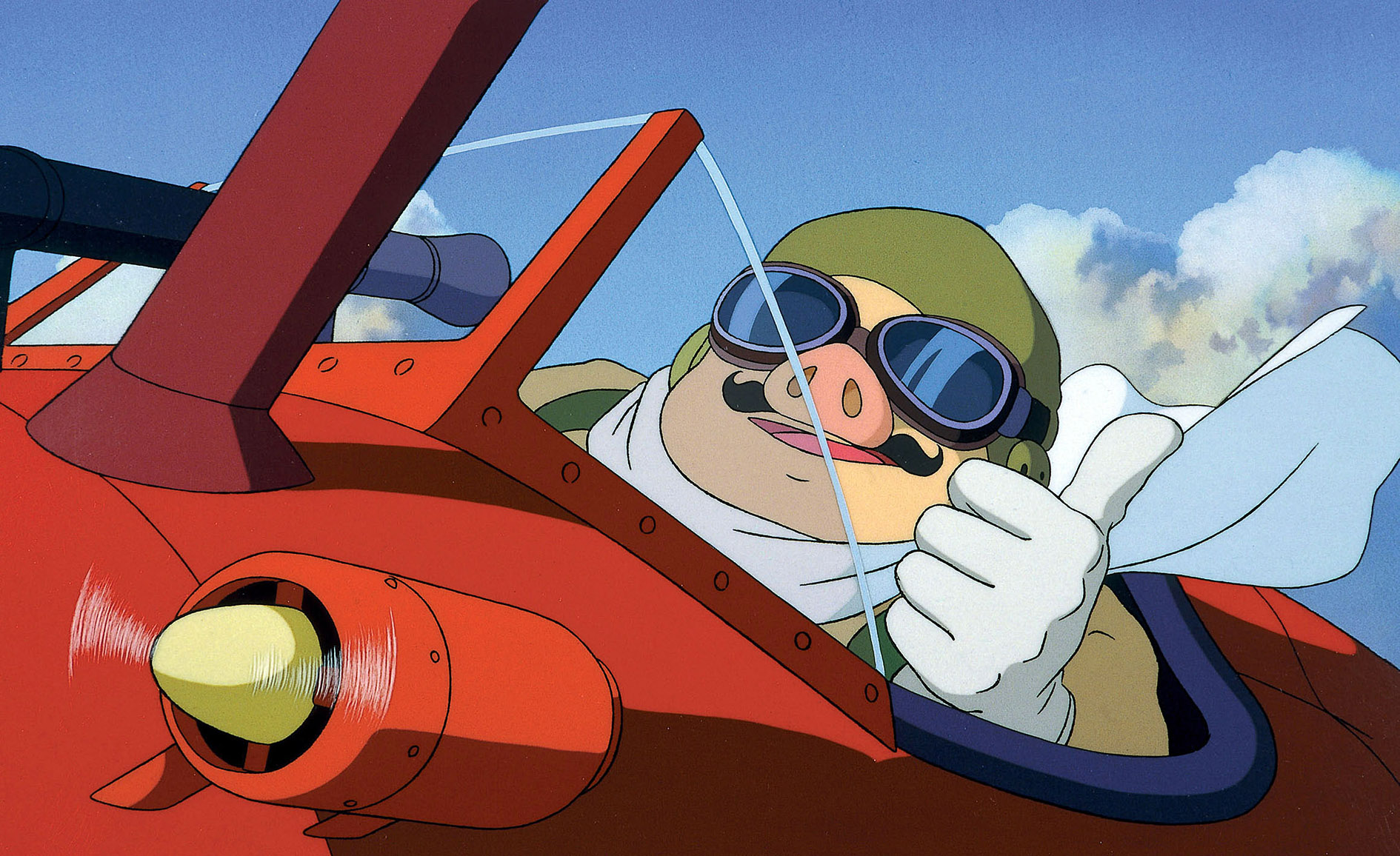Summary
Set in 1930’s Italy, a veteran World War I pilot cursed to look like a pig fights off air pirates and goes on other adventures.
My Thoughts
Like almost all of Miyazaki’s other films, this movie is like nothing I’ve ever seen before. The animation is breathtaking and beautiful; the story is full of enchantments and whimsy; and the characters are unique and interesting. It’s hard to judge Miayazaki’s films as separate entities when I’m already so much more familiar with of his other films. I love “Spirited Away”, “Howl’s Moving Castle”, and “My Neighbor Totoro” and I’d put “Princess Mononoke” in my top five films. Miyazaki has a way of bringing to life worlds brimming with magic. This film is no different, and though it isn’t quite as good as the films I previously mentioned, it still manages to sweep the viewer up in a story of flying pirates, anthropomorphic bounty hunter pigs, and a surprising amount of heart in its messages.
(SOME SPOILERS AHEAD)
The film starts with Porco Rosso, a veteran World War I pilot, now flying as a bounty hunter. He receives a call that air pirates are attacking a ferry liner and quickly comes to the liner’s aid. Rosso’s plane is falling into disrepair, and after a brief stop at a hotel, where he meets his soon-to-be rival, Curtis, Rosso makes his way towards Milan, where he can have his plane serviced. After another air battle, Curtis shoots down Rosso’s plane and believes he’s killed him. Rosso and his new sidekick, Fio, fix up the plane and eventually challenge Curtis to a duel.
(SPOILERS END)
Though I’ve just written out a general synopsis of the film above, I find it hard to say that this is all that happens in this movie. This is a strange story with a meandering plotline; one that really doesn’t have a great sense of where it’s headed from the beginning, nor does it have a stupendous conclusion at the end. This is not typical three-act story building towards a climax where everything is wrapped up nicely. Instead, it’s a fun romp through 1930’s Italy- it’s more about spending time with the characters than it is about completing some great task. Even the character changes in this movie are subtle- the most important ones are only implied.
(BIG SPOILER IN THE NEXT PARAGRAPH) I thought that much of the film would be about finding a cure for Rosso’s condition, but that plot point is barely brought up at all- the condition seems to be more metaphorical, though people still remark on it as if it’s real. We don’t even see Rosso’s final transformation back into a human, it’s only implied that his selfless actions at the end of the film prompt his regression. It’s interesting, because in the hands of some other filmmaker, that transformation from animal to man again would more than likely be overly dramatized, filled with sweeping music, and probably in slow motion (think the Beast’s transformation back to human in “Beauty and the Beast”, the frog’s transformation in “Princess and the Frog”, Ariel’s transformation in “The Little Mermaid”… you get the point, I’m sure). For kids, I wonder if that in-your-face delivery of transformation is almost needed, because in this movie, the transformation is so subtle that if you aren’t paying attention, you wont even realize he transformed back. In my opinion, it’s that kind of subtlety really sets this film apart; Miyazaki never panders to his audience: he shows you things that the first time you might understand or you might miss, but either way you’ll be entertained. (SPOILERS END.)
This story’s plotline felt more relaxed than some of his other films: “Ponyo”, “Nausicaa of the Valley of the Wind”, “Princess Mononoke”, even “Spirited Away” all have a more objective based plot, while this film feels a little more like “My Neighbor Totoro”, which is pretty much an excuse to hang out with bizarre yet charming characters. This film primarily focuses on Porco Rosso, but the others- Gina, Fio, Piccolo, even Curtis- are all just as interesting. The meandering nature of the storyline makes the stakes themselves feel a little low- we’re never really convinced that Rosso is in any kind of danger. Even in the final race/duel scene, the stakes, though they’re stated explicitly, seem quite subdued. Porco Rosso is a bounty hunter, and though it’s insinuated that he wrestles internally with being a coward for fleeing battle, he never has any qualms about the lives put in the balance by the events he sets in motion. It’s a small bone to pick, however. Miyazaki’s films rarely put the protagonist in explicit danger- they’re built around showing a new world to the viewer. They’re an experience; story, in some of his pictures, seems only a byproduct.
It’s almost redundant to mention how beautiful the artwork is in a Studio Ghibli film, but I will. Nigh every shot could be framed as artwork- the colors are rich and vivid, and the designs are meticulously detailed and show real depth to the world. Some of the flying sequences in particular have incredible cinematography- and the way the clouds are designed- with multiple levels of towering cumulus giants- makes the world feel so much more epic.
Verdict
This isn’t my favorite Miyazaki film, but it’s definitely a film I’d recommend. Miyazaki has so many incredible movies that even the ones that aren’t as perfect as his others are still worth watching. He’s an animation wizard and his stories are wrought with situations, characters, and designs that you wont find anywhere else. As a children’s film - this movie is innocent, fun, and more imaginative than most of the other cartoon movies you’ll find today- and it has less objectionable material than even modern PG movies. This is certainly a charming animated experience worth seeing.
Review Written By:





